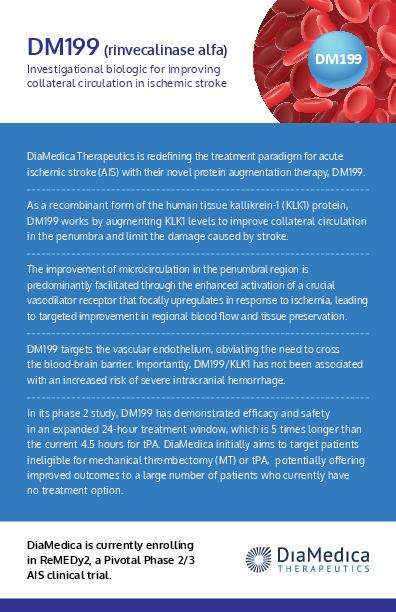Current Treatment Options for Acute Ischemic Stroke
According to the U.S. Centers for Disease Control, each year approximately 800,000 people in the United States experience a stroke, approximately 25% of these strokes are recurrent events. The overwhelming majority of strokes are ischemic in nature, meaning a blockage of blood flow in/to the brain. Treatment options for ischemic strokes are limited such that approximately 80%1 of these patients have no treatment option other than supportive care. DM199 is being studied as a potential therapeutic option to help these patients.

Currently, the only approved therapeutic available to treat acute ischemic stroke patients is Activase® (Alteplase), a tissue plasminogen activator sometimes referred to as “tPA,” which is intended to dissolve the clot causing the blockage of blood flow. However, tPA must be administered within 4.5 hours of the onset of stroke symptoms and may not be administered to patients that have a current risk of intracranial hemorrhage (bleeding).
1. Market research conducted by SyneosOne in 2020 and Journal of Stroke and Cerebrovascular Diseases, Volume 29, Issue 2, February 2020.
DM199’s Potential Role in Stroke Therapy
DM199 (rhKLK1) is a recombinant (synthetic) form of a naturally occurring protein called human tissue kallikrein-1 (KLK1). KLK1 is produced primarily in the kidneys, pancreas and salivary glands. KLK1, which is part of the Kallikrein-Kinin system, plays an important role in the regulation of local blood flow and vasodilation (the widening of blood vessels which decreases blood pressure) in the body, as well as an important role in mitigating inflammation and oxidative stress (an imbalance between potentially damaging reactive oxygen species, or free radicals, and antioxidants in the body). With age, the body’s ability to produce KLK1 may be reduced. KLK1 levels are often low in patients who have experienced a stroke and/or are at risk of a recurrent stroke.
DM199 therapy is intended to increase production of bradykinin which in turn activates a greater number of the increased bradykinin 2 receptors present in arteries affected by AIS, referred to as the ischemic penumbra, thus improving collateral circulation in the ischemic penumbra. By delivering vital oxygen and nutrients to brain tissues in need, there is the potential to preserve/restore neuronal function and reduce the size of the ischemic penumbra, minimizing neuronal cell death (infarction) and brain damage.



